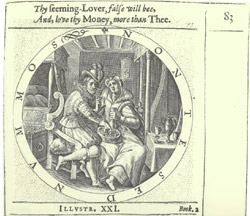Jacobean comedy in the spotlight

One of highlights of the York Festival of Ideas is a lavish production of the 17th century comedy by Thomas Middleton, A Mad World, My Masters, staged in the Department of Theatre, Film and Television’s principal theatre on Heslington East.
 Professor Mike Cordner, together with Dr Tom Cantrell and Mark Smith, are directing Thomas Middleton’s satirical masterpiece, A Mad World, My Masters (c 1605).
Professor Mike Cordner, together with Dr Tom Cantrell and Mark Smith, are directing Thomas Middleton’s satirical masterpiece, A Mad World, My Masters (c 1605).
“The play will provide an opportunity to deploy to full advantage the outstanding technical resources of the principal TFTV theatre. It is an exciting and unique performance space, in which students love to work,” says Mike.
Both set and costumes will be designed by a professional designer Alex Lowde, thanks to a generous endowment from the Sylvia and Colin Shepherd Charitable Trust.
The production is the work of TFTV’s Out of the Blue Theatre Company, which Professor Cordner founded with Professor Mary Luckhurst, and whose recent successes include Caryl Churchill’s Far Away and Mad Forest (at the York Theatre Royal), John Marston’s The Malcontent (in the Dixon Studio Theatre in Wentworth), and Raising the Roof (a comedy revue performed in the Dixon and at BAFTA in London in spring 2010). This show will employ a large cast of student actors, and the production team will be drawn from TFTV students.
Mike Cordner on Middleton:
Middleton is most famous today for writing two of the greatest 17th-century tragedies, The Changeling and Woman Beware Women. But he also created a brilliant array of entertaining and witty comedies set in early Jacobean London, which explore with relish a duplicitous and cutthroat urban world, where the best art’ of the inhabitants is ‘to dissemble well’.
A Mad World offers its audience a whirlwind ride through a series of plots and counterplots, with surprises around every corner and some of the cleverest comic dialogue of the pre-civil war stage. The action moves swiftly between radically contrasted locations and weaves together two ingenious stories of trickery and deceit (one involving money, the other adultery), in which those who think themselves most cunning (and may indeed seem to be so) do not always win the race.
Further information
- A Mad World, My Masters is on Thursday 23, Friday 24 and Saturday 25 June at 7.45pm. Tickets are available from York Theatre Royal (www.yorktheatreroyal.co.uk; tel 01904 623568).
- York Festival of Ideas
- Theatre, Film and Television
